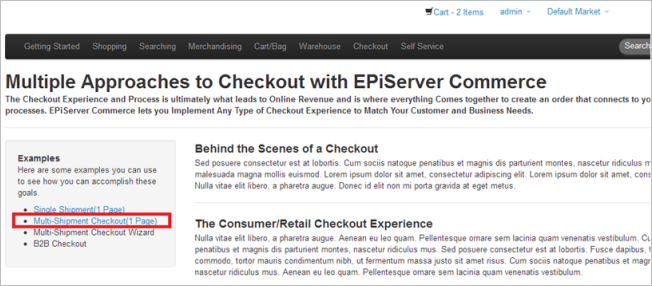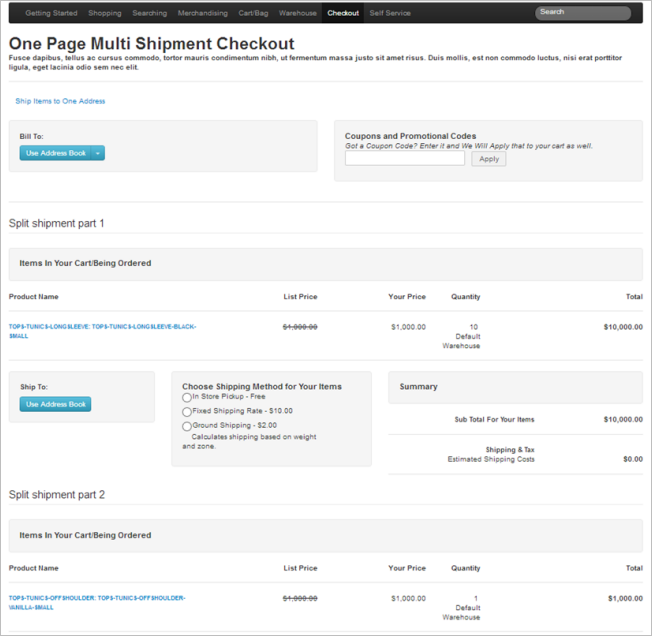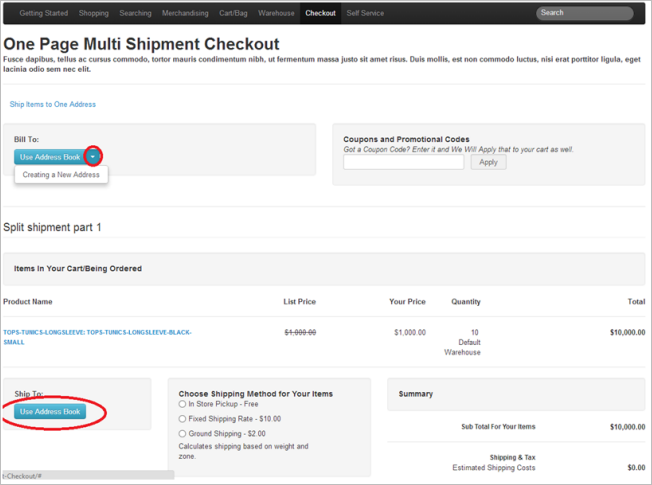Introduction
This document provides some basic examples of how to use the ECF API to work
with multi-shipment, also known as "split shipments". The multi-shipment feature allows
purchased items to be shipped to multiple address. For example, when
a customer buys two items A and B, it is possible to have the items shipped to
two different addresses. The addresses to be used can be created during
checkout, or selected from existing addresses.
How it works
This section describes how multi-shipment is implemented in the Commerce sample
templates. When a customer has purchased at least two items, the "Multi-shipment
checkout" option will be presented during checkout.

During checkout, the information for each "split shipping" part is added. The
number of "split shipments" is equivalent to the number of items in the cart,
and it is possible to add individual shipment addresses for each item.

Upon completing the information for each split shipment part, the page will be
reloaded to update the summary for each shipment, as well as the total summary.
New addresses that can be used for both billing and shipping, can be created in
each split shipment part.

Code examples
Example: Getting the billing address
C#
var Cart = new CartHelper(Mediachase.Commerce.Orders.Cart.DefaultName);
var billingAddressId = Cart.OrderForms[0].BillingAddressId;
var billingAddress = Cart.OrderAddresses.ToArray().FirstOrDefault(x =>
x.Name.Equals(billingAddressId));
Example: Creating split shipment parts based on line items
C#
var lineItems = Cart.OrderForms[0].LineItems;
foreach (LineItem lineItem in lineItems)
{
Shipment shipment = new Shipment();
shipment.CreatorId = SecurityContext.Current.CurrentUserId.ToString();
shipment.Created = DateTime.UtcNow;
shipment.AddLineItemIndex(lineItems.IndexOf(lineItem), lineItem.Quantity);
Cart.OrderForms[0].Shipments.Add(shipment);
}
Cart.AcceptChanges();
Example: Adding a shipping address to a cart
C#
Shipment shipment = Cart.OrderForms[0].Shipments.ToArray().FirstOrDefault();
if (shipment == null)
{
shipment = new Shipment();
shipment.CreatorId = SecurityContext.Current.CurrentUserId.ToString();
shipment.Created = DateTime.UtcNow;
}
shipment.ShippingAddressId = address.Name;
if (Cart.OrderForms[0].Shipments.Count < 1)
{
Cart.OrderForms[0].Shipments.Add(shipment);
}
Example: Adding a shipment method to a cart
C#
/Shipment ship = Cart.OrderForms[0].Shipments.ToArray().Where(s => s.Id == this.SplitShipment.Id).FirstOrDefault();
ship.ShippingMethodId = new Guid(shippingMethodId);
ship.ShippingMethodName = ((GlobalRadioButton)sender).Text;
OrderGroupWorkflowManager.RunWorkflow(Cart,
OrderGroupWorkflowManager.CartPrepareWorkflowName);
Cart.AcceptChanges();
Do you find this information helpful? Please log in to provide feedback.



